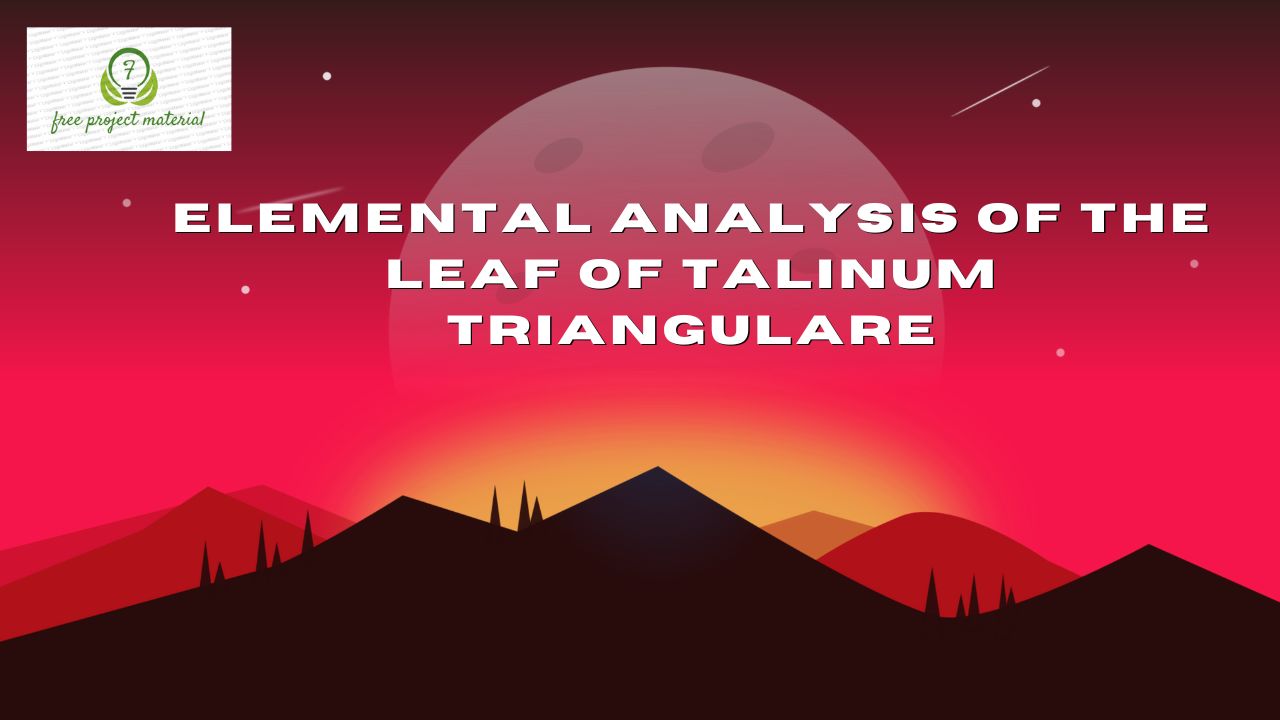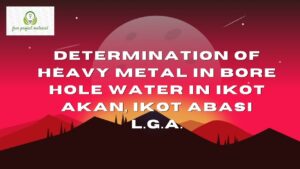ABSTRACT
This study was aimed at determining the mineral element composition of Talinum triangulare leaves. Standard analytical method procedures were employed in analyzing the samples. The result of the study revealed the following: K (17.632±0.001 mg/100g), Mg (24.031±0.101 mg/100g), Ca (16.270±0.308 mg/100g), Na (32.098±0.072 mg/100g), P (57.649±0.112 mg/100g), Cu (2.330±0.002 mg/100g), Fe (3.127±0.0031 mg/100g), Mn (1.820±0.121 mg/100g) and Zn (0.978±0.001 mg/100g). the concentration of the mineral elements analyzed were below the recommended dietary allowance (RDA), this implies that the plant does not have sufficient amount of mineral elements to meet the daily requirements as such, its consumption should be in combination with other vegetables so as to obtained the needed mineral elements required for the normal functioning of the body.
TABLE OF CONTENTS
Title page – – – – – – – – – i
Certification – – – – – – – – – ii
Dedication – – – – – – – – – iii
Acknowledgements – – – – – – – iv
Abstract – – – – – – – – – v
Table of Contents – – – – – – – – vi-vii
CHAPTER ONE
1.0 INTRODUCTION – – – – – – – 1
1.1 Background of the Study – – – – – – 1-3
1.2 Aim and Objectives of the study – – – – 3
1.3 Scope and Limitation of the study – – – – 3
CHAPTER TWO
2.0 LITERATURE REVIEW – – – – – 4
2.1 Description and Distribution of Waterleaf – – – 4-5
2.2 Taxonomy of Waterleaf – – – – – – 5-6
2.3 Elemental Composition of Waterleaf – – – – 6
2.4 Biological Uses and the function of Talinum triangulare – 7-9
2.5 Mineral Element – – – – – – – 9
2.5.1 Calcium (Ca) – – – – – – – 9-10
2.5.2 Phosphorus (P) – – – – – – – 10-11
2.5.3 Potassium (K) – – – – – – – 11-12
2.5.4 Cobalt – – – – – – – – 12-13
2.5.5 Copper (Cu) – – – – – – – – 13-14
CHAPTER THREE
3.0 MATERIALS AND METHODS – – – – 15
3.1 Materials and Reagents – – – – – – 15
3.2 Method – – – – – – – – 15
3.2.1 Sample Collection and Preparation – – – – 15
3.3.2 Digestion of the sample for Elemental Analysis – – 16
3.3.2 Instrumental Analysis Using AAS – – – – 17
CHAPTER FOUR
4.0 RESULTS AND DISCUSSION – – – – 18
4.1 Results – – – – – – – – 18-19
4.2 Discussion – – – – – – – – 20-24
CHAPTER FIVE
5.0 CONCLUSION AND RECOMMENDATIONS – – 25
5.1 Conclusion – – – – – – – – 25
5.2 Recommendations – – – – – – – 25-26
References
CHAPTER ONE
1.0 INTRODUCTION
1.1 Background of the Study
Fresh waterleaf are important sources of nourishment and a vital ingredient in healthy and balanced diets. Fresh vegetables are highly recommended in any diet virtually without quantitative restriction and the roles of vegetables in maintenance of good health are well known (Osuagwe, 2008). Waterleaf form an indispensable constituent of diet in Africa generally and west Africa in particular. Generally, they are consumed as cooked compliments to the major stables like cassava, cocoyam, guinea corn, maize, millet, rice and plantain (Oguntona, 1998). They are noted to occupy an important place among the food crops as they provide adequate amount of vitamins and minerals for human. Waterleaf are important as food both from economic and nutritional stand point. Their nutritive significance is their richness in minerals and vitamins which are essential in the maintenance of human health (Bolaji et al., 2008). The importance and awareness of nutrition is public health issues has resulted in the increase demand of knowledge of the biochemical nutrients of foods. They are good sources of carotene, ascorbic acid, riboflavin, folic acid and minerals like calcium, iron, and phosphorous (Fasuyi, 2006). Waterleaf also contain phytochemical which are nutritionally and medicinally useful but at times reduce the bioavailability of nutrients in human system (Fasuyin, 2006).
Waterleaf are eaten raw or processed. Any methods selected for processing vegetables should be such that does not adversely affect the colour, texture, flavor, and nutritional values especially the vitamins and minerals (Edeoga et al., 2006). The processing method used for vegetables therefore depends on the end product desired and storage facilities available (Cruess, 1985). Waterleaf (Talinum triangulare) is a highly perishable vegetable. It needs special processing methods to prevent decomposition. These processing method either change the native and constituents of the vegetable positively or negatively. This work is aimed to evaluate the minerals in waterleaf (Talinum triangulare).
Talinum comprises of about 40 species, with most of them found in Mexico and Southern United States, while a few (about seven species) in tropical Africa. Talinum triangulare is sometimes confused with Talinim portulacifolium, but the latter specie differs by its paniculate inflorescence which has terete axis, with sepals not prominently veined and smooth seeds (Joshua et al., 2012).
1.2 Aim and Objectives of the study
The aim of this study is to investigate the elemental composition of Talinum triangulare, leaves
The objectives of this study are;
- To determine the micro-element composition of the plant
- To determine the macro-element composition of the plant
- To make useful recommendation based on result of the study
1.3 Scope and Limitation of the Study
This study only focused on the elemental analysis of Talinum triangulare leaves, this study is limited by time and financial constrain.


